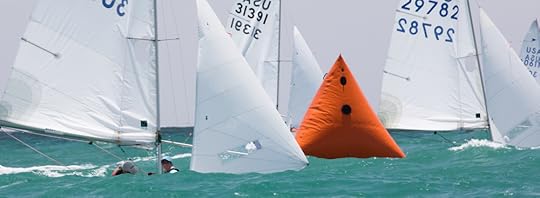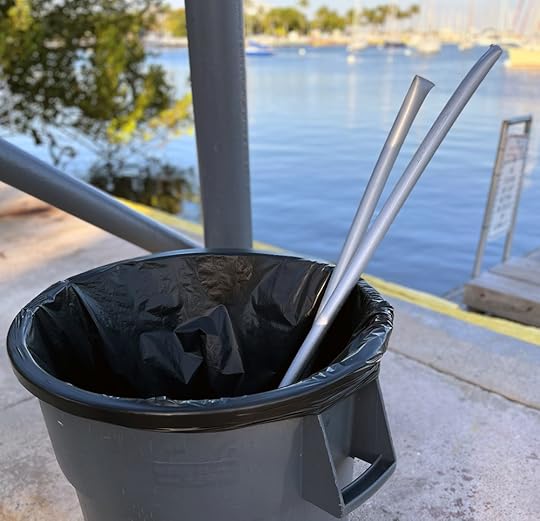Learning from a “Spectacular” Death Roll
Last weekend, after rounding the windward mark in sixth in the puffiest, shiftiest breeze I’ve ever seen on Miami’s Biscayne Bay, Kim and I set the Snipe pole for another challenging heavy air run—a carefully honed yet instinctual ballet that includes shifting our weight both side to side and fore and aft, while steering and trimming sails to keep the boat planing over the waves rather than crashing into them.
One moment, all was fine. The next, our whisker pole hit the water—and the boat pirouetted around it onto its windward side, a classic death roll. (Here’s a photo of what this looks like.)
For those of you who are not sailors, “death roll” is a more descriptive and specific term for “capsize.” “A death roll is the act of broaching to windward,” Wikipedia explains, “putting the spinnaker pole into the water and causing a crash-jibe of the boom and mainsail, which sweep across the deck and plunge down into the water.”
 This is where the Snipe whisker pole “should” be when sailing downwind: holding the jib out to windward.
This is where the Snipe whisker pole “should” be when sailing downwind: holding the jib out to windward. Fortunately, the Snipe boom is high enough that it crossed well above our heads—but once the boat was on its side, we both fell into the water. That’s when Kim asked the perfect question: “Carol, are you all right?” —which simultaneously reassured me that she was all right, too.
Unlike my only other capsize as a Snipe skipper, I managed to pull myself around to the centerboard before the boat turtled, and eventually we righted the boat—into ear-splitting, sail-slatting, chaos. The pole had bent in two but it was also thrashing around, still attached to both jib and mast. And the jib had tied itself into an overhand knot halfway up the forestay. What a mess.
The next step was to get ourselves back onboard, but instead I got separated from the boat. Fortunately a support boat appeared, and after pulling me out of the water the driver transferred me back onto the Snipe. Once Kim pulled herself back onboard, we turned our attention to getting our sails under control again. The race was over for us, but we still needed to sail back to the dock.
Kim suggested tacking, and as soon as we got the bow through head to wind the jib somehow untied itself. She still couldn’t trim it in more than halfway because of that broken pole—but fortunately, our course back to the harbor was a reach rather than dead upwind.
After 12 years of sailing Snipes together, Kim and I no longer need to rehash the routine mistakes. But we always try to learn from new surprises, so on the sail back to the dock we had a frank discussion about where things went pear-shaped. Since we didn’t understand the cause and couldn’t come to any firm conclusions, we moved on to hashing out a plan for the next challenge: how to separate pole from jib so we could tack up the channel into the harbor.
None of our ideas worked, but somehow Kim managed to coax the double-bent pole around the mast without it doing any more damage. She also found a way to trim the jib sheet in enough to sail upwind. By the time we made it back to the dock, there were a few other broken boats already there; a good reminder that it had been a very tough day of sailing for everyone.
Thanks to a few key friends, we were able to replace our broken pole that afternoon (and also straighten our bent mast). On Sunday we posted two of our best finishes of the regatta, ending on a much better note—and leaving us both hungry for more.

Even days later, after several discussions with other Snipe experts (which included the phrase “second most spectacular death roll ever”), I still cannot fully explain the cause. Augie Diaz was right next to us when it happened; he said we’d dropped into a very deep trough between two waves, which would’ve made it impossible to steer. I think we must’ve also had a simultaneous wind shift—but I’ll never know for sure. All I can do is try not to take Wikipedia’s words too personally: “During a death roll the [keel] boat rolls from side to side, becoming gradually more unstable until either it capsizes or the skipper reacts correctly to prevent it.” (Italics mine.)
Snipes are quirky boats, and even in my 32nd season (and 12 with Kim), I’m still learning their tricks. But adding “how to tack with a broken pole” to your list of skills probably won’t be much help in the future, so instead I’ll share some more general “hindsight’ thoughts from our experience—with the sincere hope that no one else ever has to experience quite such a “spectacular” death roll ever again.
1. Check on your teammate(s) first Boats and equipment can be replaced.2. Always carry a knife onboardand make sure it is sharp enough to cut through a high-tech line.
3. Talk through disasters afterwardto see what you can learn from them. (And if it was just a freak accident, don’t beat yourself up about it.)
4. Fitness is a safety featureKim and I would not have been able to manage the extra demands of righting the boat, swimming, and then self-rescuing ourselves and our broken equipment if we weren’t both aerobically fit. (Actually, she’s an aerobic monster.) You never know when you’ll need that extra stamina that only daily workouts will provide.
Sailing Snipes in big breeze is one of the most challenging things I’ve ever done, and all it takes is one freak wave for both loads and variables to escalate. I can’t wait for another chance to test my downwind skills—and here’s hoping I won’t need any of the lessons learned last weekend, ever again.
Got a “spectacular” capsize/death roll memory? Share it in the comments below, or send me an email. I read every one, with thanks!
The post Learning from a “Spectacular” Death Roll appeared first on Carol Newman Cronin.



